Electronic Circuits - interfacing with a Z80 microprocessor v7 (output to I/O device)
My seb80 custom computer now has its own page here
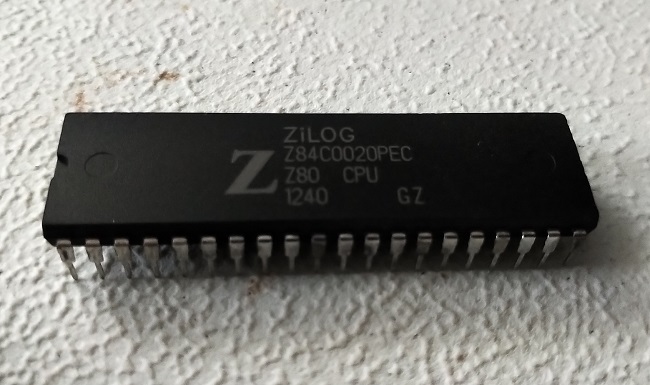
This is version 7 of my Z80 interfacing project. My goal in this version was to introduce an I/O output device, which could receive data written to it via the OUT instruction.
Previous versions:
Previous versions:
- version 1 - initial wire-up, executes NOPs, observe incrementing address
- version 2 - experiment with and observe machine cycles M2 (memory read) and M3 (memory write)
- version 3 - address and data buses
- version 4 - introduce ROM and run program from it
- version 5 - introduce RAM
- version 6 - oscillator clock, NMI button, and INT/NMI tests
I made my first steps into I/O device interfacing. The test I/O output device I created consists of LEDs which display the last value written to the device's port.
The device's entry point is a 74LS373 octal d-type latch which snapshots the data bus when enabled. It is enabled by one of the outputs of a 74LS138 3-to-8 decoder, which serves as an output device selector.
The latch output is buffered by a 74LS244, which provides sufficient current for the LEDs.
See the log below for program listings.
TP4 - test program for I/O output
TP5 - increment-and-output test program for I/O

Log
day 1Began designing the I/O circuit. My plan is to expose selectors for eight different I/O devices via a 74LS138 3-to-8 decoder (part is SN74LS138N).
Wiring this up to A0-A2 will allow easy access to I/O ports 0 through 7.
For the prototyping stage (on the breadboard), I want to wire up and output device made up of 8 LEDs which will display the last value written to the respective I/O port.
I realized that by adding a second 74LS138 3-to-8 decoder I could expose 4 input and 4 output devices with no further chips.
One 74LS138 will rely on Z80's RD line to become enabled and the other will rely on Z80's WR line to become enabled.
Address line A2 will select between the first 4 and the next 4.
I/O devices at port 0, 1, 2, 3 (A2=0) will be input devices.
I/O devices at port 4, 5, 6, 7 (A2=1) will be output devices.
NOTE: for input devices that won't rely on these built-in selectors, care has to be taken that they are wired to ports whose A2=1, to not conflict with the built-in input device selectors which expect A2=0.
Output devices:
A2 A1 A0
C B A Y
1 0 0 Y4 output device at port 4
1 0 1 Y5 output device at port 5
1 1 0 Y6 output device at port 6
1 1 1 Y7 output device at port 7
day 2
Wired the 74LS138 which will select between four output devices.
Wrote TP4, my first I/O output test program.
Address Bytes Mnemonic
0000 ; TP4
0000 ; test program for I/O output
0000 ;
0000 3E 81 LD A, 10000001b
0002 D3 04 OUT (04h), A
0004 3E C3 LD A, 11000011b
0006 D3 05 OUT (05h), A
0008 3E E7 LD A, 11100111b
000A D3 06 OUT (06h), A
000C 3E FF LD A, 11111111b
000E D3 07 OUT (07h), A
0010 C3 00 00 JP 0000h
Verified with a multimeter that the output device selector (74LS138) works as intended.
Since the main breadboard is running out of room, I've brought out the data lines onto a side breadboard.
Designed the first output device: 8 LEDs.
It's based on 74LS373 (part is DM74LS373N) octal d-type latch (transparent). While this latch has the advantage of having a level-sensitive LE (latch enable), it is active high, unlike all other TTL chips I've used so far. Luckily, my 74LS04 hex inverter still has some free slots.
The I/O output device selector was already tested, so all I had to do is connect a small breadboard which already had LEDs and a 74LS244 buffer wired up.
Wrote program TP5, below, which is supposed to successively write higher values to an output device, with visible delay. NMI should reset the value to 0.
Address Bytes Mnemonic
0000 ; TP5
0000 ; second test program for I/O output
0000 ; increment value written to output port (with
0000 ; visible delay)
0000 ; NMI clears counter to zero
0000 ;
0000 3E 00 LD A, 0
0002 32 0F F0 LD (0F00Fh), A ; counter := 0
0005 MAIN_LOOP:
0005 ; here, A = counter value
0005 D3 06 OUT (06h), A ; output counter value
0007 01 DE 08 LD BC, 2270 ; busy wait iteration count
000A DELAY:
000A 0B DEC BC ; 4 clocks
000B 78 LD A, B ; 4 clocks
000C B1 OR C ; 4 clocks
000D ; (MSB OR LSB) = 0?
000D C2 0A 00 JP NZ, DELAY ; 10 clocks
0010 ; no, keep looping
0010 21 0F F0 LD HL, 0F00Fh
0013 34 INC (HL)
0014 3A 0F F0 LD A, (0F00Fh)
0017 C3 05 00 JP MAIN_LOOP
001A FF FF ... DB 76 DUP (0FFh) ; pad up to NMI handler start
0066 NMI_HANDLER:
0066 3E 00 LD A, 0
0068 32 0F F0 LD (0F00Fh), A ; counter := 0
006B ED 45 RETN ; return from NMI
The program ran successfully! The counter was observable on the LEDs of the output device and NMI successfully reset the counter to zero.
day 4
Updated diagram
Z80 diagrams
Here are some useful diagrams, including the Z80 pinout, timing diagrams, etc.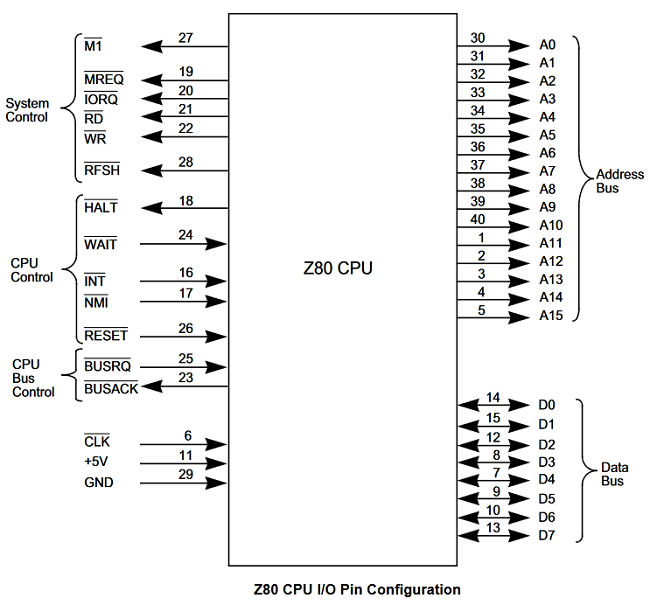

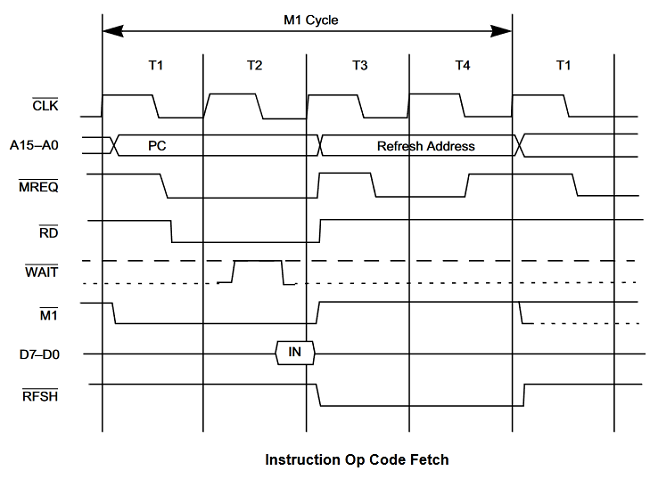


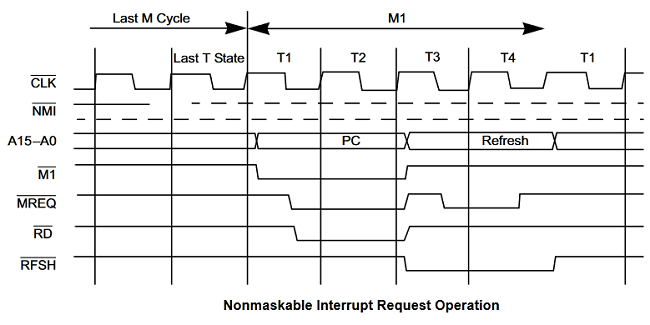



27C256 EPROM diagrams
Here are some useful diagrams, including pinout, timing, etc.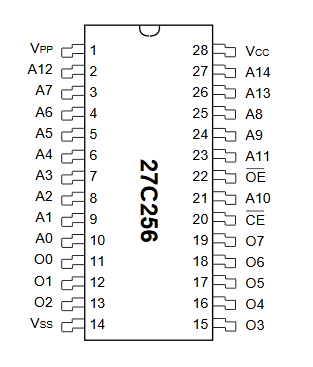

62256 RAM diagrams
Here are some useful diagrams, including pinout, timing, etc.


